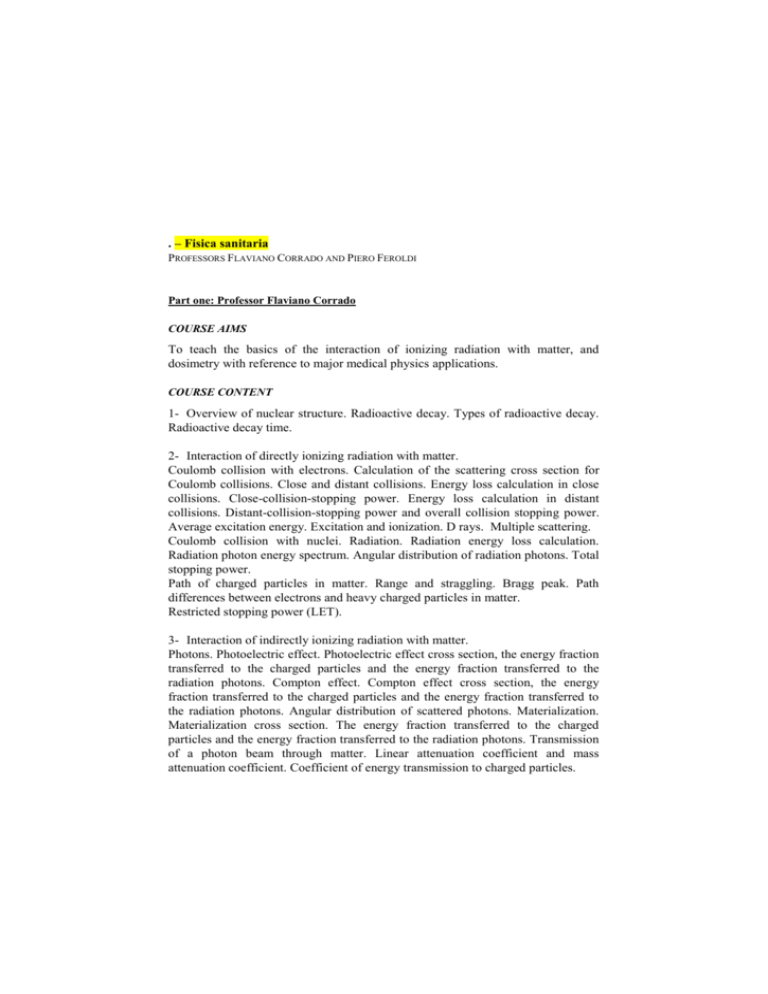Fisica sanitaria
advertisement

. – Fisica sanitaria PROFESSORS FLAVIANO CORRADO AND PIERO FEROLDI Part one: Professor Flaviano Corrado COURSE AIMS To teach the basics of the interaction of ionizing radiation with matter, and dosimetry with reference to major medical physics applications. COURSE CONTENT 1- Overview of nuclear structure. Radioactive decay. Types of radioactive decay. Radioactive decay time. 2- Interaction of directly ionizing radiation with matter. Coulomb collision with electrons. Calculation of the scattering cross section for Coulomb collisions. Close and distant collisions. Energy loss calculation in close collisions. Close-collision-stopping power. Energy loss calculation in distant collisions. Distant-collision-stopping power and overall collision stopping power. Average excitation energy. Excitation and ionization. D rays. Multiple scattering. Coulomb collision with nuclei. Radiation. Radiation energy loss calculation. Radiation photon energy spectrum. Angular distribution of radiation photons. Total stopping power. Path of charged particles in matter. Range and straggling. Bragg peak. Path differences between electrons and heavy charged particles in matter. Restricted stopping power (LET). 3- Interaction of indirectly ionizing radiation with matter. Photons. Photoelectric effect. Photoelectric effect cross section, the energy fraction transferred to the charged particles and the energy fraction transferred to the radiation photons. Compton effect. Compton effect cross section, the energy fraction transferred to the charged particles and the energy fraction transferred to the radiation photons. Angular distribution of scattered photons. Materialization. Materialization cross section. The energy fraction transferred to the charged particles and the energy fraction transferred to the radiation photons. Transmission of a photon beam through matter. Linear attenuation coefficient and mass attenuation coefficient. Coefficient of energy transmission to charged particles. Neutrons. Elastic collisions. Energy balance in elastic collisions. Inelastic collisions. Non-elastic collisions. Spallation. 4- Dosimetry. Particle flux density, energy distribution of particle flux density and fluence. Kerma: relationship between kerma and photon fluence. Absorbed dose: relationship between absorbed dose and photon fluence; relationship between absorbed dose and charged particle fluence. Radiation equilibrium. Charged particle equilibrium. Cavity theory. Small cavity. Dose calculation using the Bragg-Gray method. Dose calculation using the Spencer-Attix method. Large cavity. ‘Real’ cavity. Detector identical to the material in which the dose is calculated. Detector equivalent to the material. Fano's theorem. Detector with wall equivalent to the sensitive area. Detector with wall equivalent to the material in which the dose is calculated. Photon beam transmission through matter: percentage dose according to depth. Build-up. Radiation beam transport equations. Calculation of radiation beam transport using the Monte Carlo method. 5- Overview of particle detectors. Part two: Professor Piero Feroldi COURSE AIMS To learn about and describe the transfer of energy from radiation fields to elements of living matter parametrically, specifically in the case of ionizing radiation. To analyse the natural and artificial sources of ionizing radiation. To learn about and use physical-medical dosimetry methods and tools. To describe the uses of ionizing radiation in the medical field, diagnosis and therapy. To outline models for radiobiology and categorize dose-response relationships. To learn about and apply the physical principles of radiation protection of patients, medical workers and the public. To learn about the radiation protection guidelines, with their scientific and epidemiological references. To keep up to date on European and international directives and the Italian legislation on radiation protection. COURSE CONTENT 1) Ionizing and nonionizing radiation – Natural and artificial radioactivity – X-ray equipment. 2) Radioisotopes for medical, diagnostic and therapeutic applications. 3) X-ray apparatus for medical, diagnostic and therapeutic applications. 4) Interactions of ionizing radiation with biological targets – Energy balances Dosimetry and dosing quantities. 5) Applied dosimetry – Clinical dosimetry – Dosimetry for radiation protection. 6) Spatial and temporal absorbed dose profiles – Intracellular targets – Direct and indirect injury mechanisms – Cell survival curves – Modelling. 7) Physical, chemical and biological radiosensitivity factors. 8) Overview of the epidemiology of radiation exposure – Parametric doseresponse relationships – Tissue effects – Stochastic effects – Linear nothreshold model – Risks and their estimation. 9) Detriment – Assumptions and rudiments of radiation protection of patients, medical workers and the public – Comparison with natural and working risks. 10) Preventive assessment, optimization, limitation and verification of dosimetry for medical practices – Special medical practices. 11) Organ and tissue dose estimation – Pelvic organ, embryo and foetal dose estimation. 12) Physical principles of radiation protection – Distances, times and screens – Overview of radiation protection analysis and calculation . 13) Overview of the Italian legislation in force on radiation protection, with application references. 14) Trends in medical physics in diagnostic and therapeutic practice. READING LIST For the two parts of the course: 1) U. AMALDI, ‘Fisica delle radiazioni’, Boringhieri, 1971. 2) F.H. ATTIX - W.C. ROESCH, ‘Radiation Dosimetry’ vol. 1, Academic Press, 1968 (chapters 1, 5 and 8) 3) GLENN F. KNOLL, “Radiation, Detection and Measurement” 3rd Edition, John Wiley & Sons, New York USA, 2000 4) Lecture notes. TEACHING METHOD Lectures. ASSESSMENT METHOD Oral examinations. NOTES Further information can be found on the lecturer's webpage http://www2.unicatt.it/unicattolica/docenti/index.html or on the Faculty notice board. at







